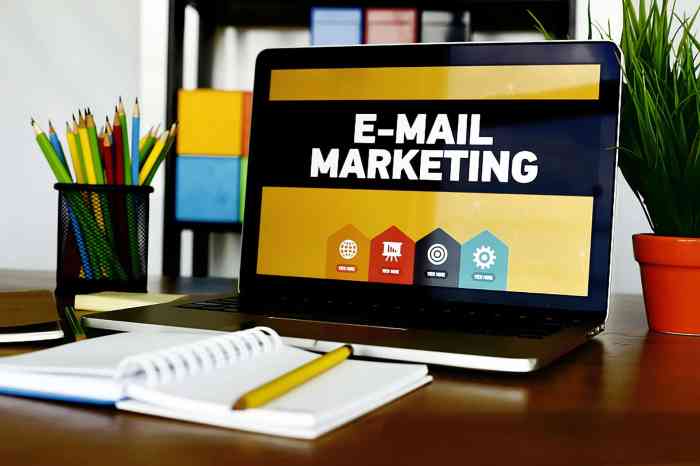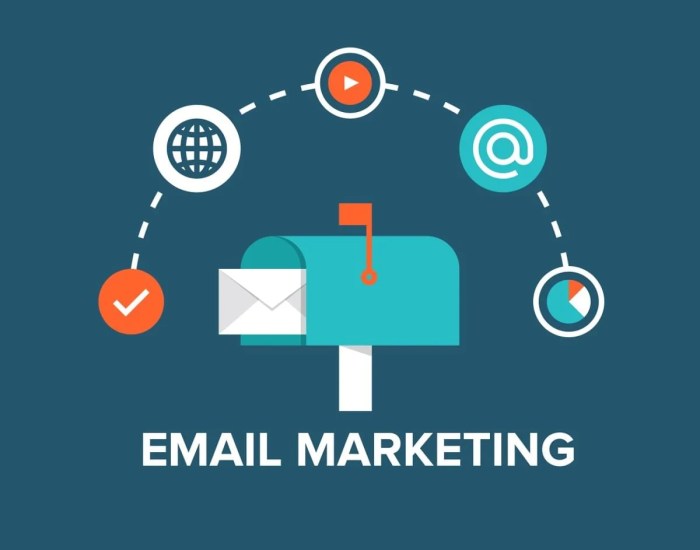Email Marketing Campaigns – a key tool in today’s digital world. Dive into the world of successful campaigns with us!
From defining concepts to measuring performance, we’ve got you covered. Let’s unlock the secrets of effective email marketing together.
Introduction to Email Marketing Campaigns
Email marketing campaigns are strategies used by businesses to reach out to their target audience through email messages. These campaigns can include promotional offers, newsletters, product updates, and more.
For businesses, email marketing campaigns are crucial for building customer relationships, increasing brand awareness, driving sales, and promoting customer loyalty. By delivering personalized content directly to their inbox, businesses can engage with their audience on a more personal level.
Examples of Successful Email Marketing Campaigns
Here are some examples of successful email marketing campaigns:
- An email campaign by Airbnb that targeted inactive users with personalized recommendations based on their previous bookings.
- A campaign by Starbucks that offered a free birthday drink to their loyalty program members, driving customer engagement and loyalty.
- The “Black Friday Deals” email campaign by Amazon, which showcased limited-time offers and discounts to drive sales during the holiday season.
Elements of an Effective Email Marketing Campaign: Email Marketing Campaigns

When it comes to running a successful email marketing campaign, there are several key elements that can make a big difference in engaging your audience and driving results. From compelling subject lines to personalized content, each element plays a crucial role in the success of your campaign.
Subject Lines
The subject line is the first thing your recipients see when they receive your email. It’s like the cover of a book – it needs to be attention-grabbing and enticing enough to make them want to open it. A good subject line should be concise, relevant, and create a sense of urgency or curiosity. With so many emails flooding inboxes every day, having a strong subject line can make all the difference in whether your email gets opened or ignored.
Personalized Content
Personalization is key in today’s digital marketing landscape, and email campaigns are no exception. By tailoring your content to the preferences and behaviors of your audience, you can create a more meaningful connection with them. Personalized emails have higher open and click-through rates because they feel more relevant and engaging to the recipient. Whether it’s addressing them by name, recommending products based on their past purchases, or sending targeted offers, personalized content can significantly improve the effectiveness of your email marketing campaigns.
Strategies for Designing Engaging Emails
When it comes to email marketing campaigns, the design of your emails plays a crucial role in capturing your audience’s attention and driving engagement. Here are some strategies for creating visually appealing and engaging email templates.
Create Visually Appealing Email Templates
To design engaging emails, it’s essential to pay attention to the visual elements of your email templates. Here are some tips to help you create visually appealing emails:
- Use eye-catching colors and fonts that reflect your brand’s identity.
- Incorporate high-quality images and graphics to make your emails visually appealing.
- Keep the design clean and organized to improve readability and navigation.
- Include white space to avoid overwhelming your readers with too much content.
Importance of Responsive Design for Email Campaigns
Responsive design is crucial for email campaigns as it ensures that your emails are optimized for various devices, including smartphones and tablets. Here are some reasons why responsive design is important:
- Mobile devices account for a significant portion of email opens, so responsive design ensures a seamless user experience across different devices.
- Responsive emails adapt to different screen sizes, making it easier for readers to engage with your content.
- Google prioritizes mobile-friendly content, so responsive design can improve your email deliverability and visibility.
Best Practices for Optimizing Email Layout and Structure
Optimizing the layout and structure of your emails is essential for driving better engagement and conversions. Here are some best practices to consider:
- Place the most important information above the fold to capture readers’ attention immediately.
- Use a clear and compelling call-to-action (CTA) that stands out and prompts readers to take action.
- Segment your email list to deliver personalized content that resonates with different audience segments.
- Test different email designs, layouts, and CTAs to identify what resonates best with your audience.
Email List Building and Segmentation
Building an email list for a campaign involves collecting contact information from potential customers or subscribers who have opted to receive communication from your brand. This can be done through website sign-up forms, social media promotions, or in-person events where people provide their email addresses voluntarily.
Segmenting email lists based on user data is crucial for personalized and targeted communication. By dividing your email list into different segments based on factors such as demographics, purchase history, or engagement levels, you can send tailored messages that resonate with each group of recipients.
Benefits of Email List Segmentation
- Increased Relevance: Sending personalized content to specific segments leads to higher engagement rates.
- Improved Open Rates: Targeted emails are more likely to be opened and read by recipients.
- Enhanced Conversion Rates: Tailored messages can drive more conversions and sales.
Strategies for Effective Email List Segmentation
- Use Demographic Data: Segment your list based on age, gender, location, or other relevant demographics.
- Behavioral Segmentation: Group subscribers based on their interactions with your emails or website.
- Purchase History: Create segments for customers who have made purchases and personalize offers accordingly.
- Engagement Levels: Segment subscribers based on their level of interaction with your emails to send targeted campaigns.
Email Automation and Personalization

Email automation involves setting up emails to be sent automatically based on triggers or schedules, saving time and ensuring timely communication with subscribers. The benefits of email automation include increased efficiency, improved targeting, and the ability to nurture leads through personalized and relevant content.
Benefits of Email Automation:
- Save time and resources by scheduling emails in advance.
- Improve targeting by sending the right message to the right audience at the right time.
- Nurture leads by sending personalized content based on subscriber behavior.
Role of Personalization:
Personalization is key to increasing email campaign effectiveness as it allows you to tailor your messages to the individual preferences and behaviors of your subscribers. By personalizing emails, you can create a more engaging and relevant experience for your audience, leading to higher open rates, click-through rates, and ultimately, conversions.
Examples of Automation and Personalization:, Email Marketing Campaigns
Automated welcome emails sent to new subscribers with a personalized message.
Abandoned cart emails triggered by a subscriber leaving items in their online shopping cart.
Personalized recommendations based on previous purchases or browsing history.
Measuring Email Marketing Campaign Performance
In the world of email marketing, it’s crucial to measure the performance of your campaigns to understand what’s working and what needs improvement. Let’s dive into the key metrics, the significance of A/B testing, and tools for tracking and analyzing data.
Key Metrics for Measuring Success
- Open Rate: The percentage of recipients who opened your email. A high open rate indicates strong subject lines and sender credibility.
- Click-Through Rate (CTR): The percentage of recipients who clicked on a link within your email. It shows the effectiveness of your content and call-to-action.
- Conversion Rate: The percentage of recipients who completed the desired action after clicking on a link. It measures the impact of your email on driving actions.
- Bounce Rate: The percentage of emails that couldn’t be delivered to recipients’ inboxes. High bounce rates can harm your sender reputation.
- Unsubscribe Rate: The percentage of recipients who opted out of receiving future emails. It reflects the quality of your content and targeting.
Importance of A/B Testing
A/B testing involves creating two versions of an email with slight variations to determine which performs better. This method helps optimize campaign performance by testing elements like subject lines, visuals, CTAs, and content. It provides valuable insights into what resonates with your audience and drives higher engagement.
Tools for Tracking and Analyzing Performance
Google Analytics:
A powerful tool for tracking email campaign performance, from open rates to conversions. It offers detailed insights into user behavior and helps in refining your email strategy.
Email Service Provider Analytics:
Platforms like Mailchimp, Constant Contact, or HubSpot provide analytics on key metrics and audience engagement. They offer reports and data visualization to monitor campaign effectiveness.
Heat Mapping Tools:
Tools like Hotjar or Crazy Egg help visualize how recipients interact with your emails. Heat maps show where users click, scroll, or spend the most time, aiding in optimizing email layouts for better engagement.
Compliance and Best Practices in Email Marketing
In the world of email marketing, it’s crucial to follow legal requirements and best practices to ensure the success of your campaigns. Let’s dive into compliance and some tips to keep your emails out of the spam folder.
Legal Requirements and GDPR Compliance
To protect the privacy of individuals in the European Union, the General Data Protection Regulation (GDPR) sets guidelines for collecting, processing, and storing personal data. When it comes to email marketing, you must obtain explicit consent from recipients before sending them promotional emails. Make sure to include an unsubscribe option in every email and provide clear information on how their data will be used. Failure to comply with GDPR regulations can result in hefty fines, so it’s essential to stay informed and follow the rules.
Best Practices for Email Marketing Compliance
– Only send emails to recipients who have opted in to receive them.
– Include a visible and easy-to-use unsubscribe link in every email.
– Clearly identify your business or organization in the email.
– Avoid using misleading subject lines or deceptive content.
– Regularly update your email list to remove inactive or unsubscribed contacts.
Maintaining Sender Reputation and Avoiding Spam Filters
– Monitor your email deliverability rates and engagement metrics.
– Use a reputable email service provider to ensure proper email authentication.
– Avoid using spam trigger words like “free,” “urgent,” or excessive punctuation in your subject lines.
– Segment your email list based on user behavior and preferences to send targeted and relevant content.
– Regularly clean your email list to remove invalid or outdated addresses.












